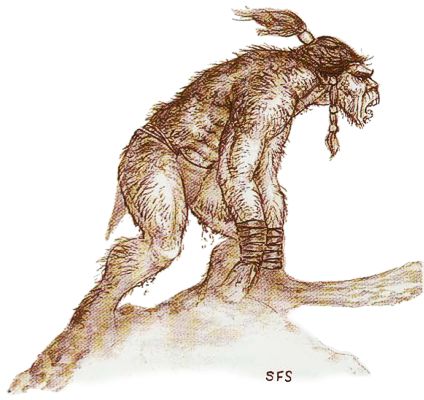

Dragon #254

| Climate/Terrain: | Any hills and mountains |
|---|---|
| Frequency: | Very rare |
| Organization: | Solitary |
| Activity Cycle: | Night |
| Diet: | See below |
| Intelligence: | Low (5-7) |
| Treasure: | D |
| Alignment: | Chaotic evil |
| No. Appearing: | 1-3 |
| Armor Class: | 2 |
| Movement: | 10 |
| Hit Dice: | 13 |
| THAC0: | 7 |
| No. of Attacks: | 1 |
| Damage/Attack: | 1d8+7 or by weapon (2d8+7) |
| Special Attacks: | Energy drain, hurling rocks for 2d10 |
| Special Defenses: | Hit only by silver or +1 or better magical weapon |
| Magic Resistance: | See below |
| Size: | H (16' tall) |
| Morale: | Elite (14) |
| XP Value: | 12,000 |
Barrowes are undead hill giants, even uglier than their living counterparts. They go about naked but do not seem to be so, for their bodies sport a thick growth of matted, filthy hair. This thick fur, allied with the toughness of their undead hide, gives them an armor class of 2. Their eyes glitter like those of all undead, but because the eyes are small, and because the giant stoops over so much, it is often hard to make them out at a distance, leading to disastrous errors in identification.
Combat: Barrowes can use any attack form they did in life, being slightly stronger in undead form. They inflict 1d8+7 hp damage per hit. They cause 2d8+7 hp damage when wielding a weapon, and boulders they hurl inflict 2d20 hp damage. They have a maximum range of 250 yards when hurling boulders. Due to a loss of Dexterity that comes with undeath, barrowes cannot catch hurled boulders. Barrowes can be struck only by weapons of +1 enchantment or better, unless the non-magical weapon is of silvered steel. They suffer 2d4 hp damage per vial of holy water.
After a successful melee attack with an unarmed fist, barrowes drain one experience level unless the victim saves vs. death magic. Anyone totally drained in this manner becomes a miniature barrowe, undergoing a shocking transformation. The victim sheds his clothes or sees them ripped or split off as his body becomes overly muscular, hunchbacked, and apelike. He also gains all the powers of a barrowe except those of great Strength and boulder-hurling, but he retains only half of his Hit Dice. (Note: A barrowe can make another true barrowe only by slaying another giant with its energy-draining attack.) Due to the stupidity of hill giants, however, any barrowes thus created are not controlled by their slayer, wandering off to find lairs.
Barrowes are immune to all mind-affecting spells, as well as sleep, hold, poison, paralyzation, or cold-based attacks. A raise dead spell, however, instantly slays the monster. Barrowes are intolerant of bright sunlight and actively avoid it, although it does them no real harm.
Habitat/Society: These creatures exist alone or in small groups, placing no value on the company of others. Their lairs in death are much the same as in life: caverns and other gloomy hill-country lairs, such as deep forests.
Barrowes have no fondness for their living kin. They frequently go out of their way to wipe out a former family, tribe, or raiding band, just for the satisfaction of breaking it up. Remember, the barrowe gains no followers when it creates more of its kind: the new undead simply wander away. The only pleasure a barrowe knows comes from breaking up the formerly close-knit bonds of its kin, causing them to separate and become as lonely as it is.
Ecology: Barrowes exist as much on the Negative Material Plane as on the Prime. The negative energy from the former plane sustains them and provides their life-draining abilities, though they achieve as much satisfaction draining a living being as they once gained from filling an empty stomach. Their only impact on a region's ecology is to ensure that it has none: animals sense the undead presence and flee the area, while the local vegetation slowly withers and dies within a quarter-mile of the creature's lair. Some sages speculate that using the parts of a barrowe in the production of an otherwise standard potion of hill giant strength grants the imbiber energy-draining abilities as well as increased strength, but so far as is known, no one has been foolhardy enough to try it.
